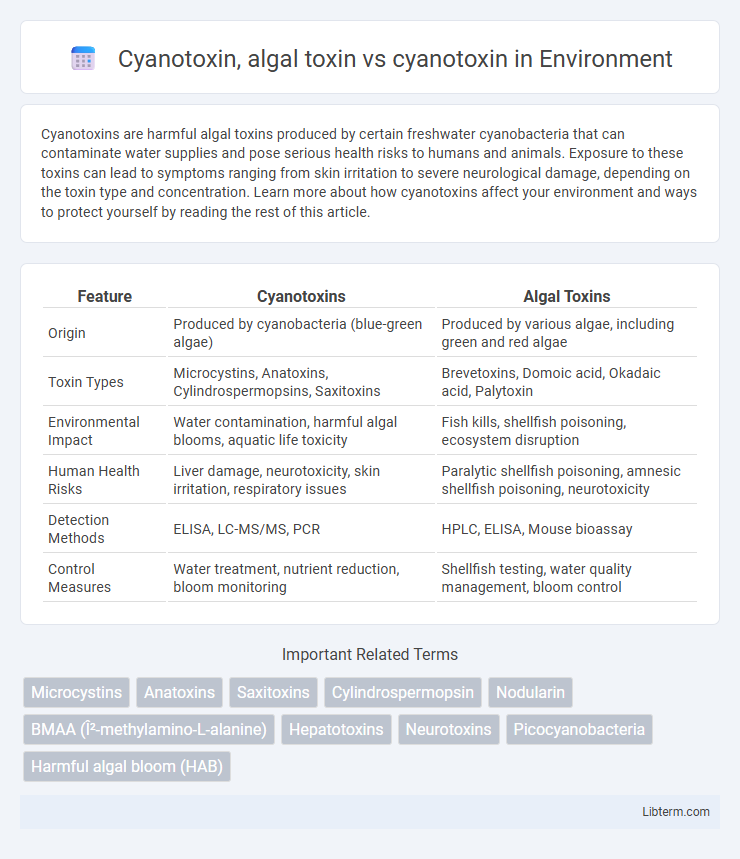Cyanotoxins are harmful algal toxins produced by certain freshwater cyanobacteria that can contaminate water supplies and pose serious health risks to humans and animals. Exposure to these toxins can lead to symptoms ranging from skin irritation to severe neurological damage, depending on the toxin type and concentration. Learn more about how cyanotoxins affect your environment and ways to protect yourself by reading the rest of this article.
Table of Comparison
| Feature | Cyanotoxins | Algal Toxins |
|---|---|---|
| Origin | Produced by cyanobacteria (blue-green algae) | Produced by various algae, including green and red algae |
| Toxin Types | Microcystins, Anatoxins, Cylindrospermopsins, Saxitoxins | Brevetoxins, Domoic acid, Okadaic acid, Palytoxin |
| Environmental Impact | Water contamination, harmful algal blooms, aquatic life toxicity | Fish kills, shellfish poisoning, ecosystem disruption |
| Human Health Risks | Liver damage, neurotoxicity, skin irritation, respiratory issues | Paralytic shellfish poisoning, amnesic shellfish poisoning, neurotoxicity |
| Detection Methods | ELISA, LC-MS/MS, PCR | HPLC, ELISA, Mouse bioassay |
| Control Measures | Water treatment, nutrient reduction, bloom monitoring | Shellfish testing, water quality management, bloom control |
Introduction to Cyanotoxins
Cyanotoxins are toxic compounds produced by certain species of cyanobacteria, commonly known as blue-green algae, during harmful algal blooms in freshwater and marine environments. Unlike general algal toxins, which can be produced by various algal groups, cyanotoxins specifically originate from photosynthetic cyanobacteria and include microcystins, anatoxins, cylindrospermopsin, and saxitoxins. These toxins pose significant risks to human health, aquatic life, and water quality, making their monitoring and management critical for environmental safety.
Overview of Algal Toxins
Algal toxins comprise a broad group of toxic compounds produced by various algae, including dinoflagellates, diatoms, and cyanobacteria. Cyanotoxins are a specific subset of algal toxins solely produced by cyanobacteria, often associated with harmful algal blooms in freshwater systems. These toxins vary widely in chemical structure and toxicity, impacting water quality, aquatic ecosystems, and human health through exposure to contaminated water or consumption of affected aquatic organisms.
What are Cyanotoxins?
Cyanotoxins are toxic compounds produced by cyanobacteria, also known as blue-green algae, during harmful algal blooms in freshwater and marine environments. Unlike algal toxins, which can originate from various algae species including dinoflagellates and diatoms, cyanotoxins specifically derive from cyanobacteria and pose significant risks to human health, aquatic life, and livestock through exposure to contaminated water. Key cyanotoxins include microcystins, anatoxins, saxitoxins, and cylindrospermopsin, each with distinct toxicological effects such as hepatotoxicity, neurotoxicity, and dermatotoxicity.
Differences Between Algal Toxins and Cyanotoxins
Cyanotoxins are a specific group of algal toxins produced exclusively by cyanobacteria, whereas algal toxins encompass a broader category including toxins from various algae such as dinoflagellates and diatoms. Cyanotoxins like microcystins and anatoxins primarily contaminate freshwater systems, while algal toxins may occur in both freshwater and marine environments with examples like saxitoxins and domoic acid. The distinct biosynthetic pathways and ecological impacts, including toxicity mechanisms such as liver damage by cyanotoxins versus neurotoxicity from some marine algal toxins, highlight key differences between these toxin groups.
Common Types of Cyanotoxins
Common types of cyanotoxins include microcystins, anatoxins, cylindrospermopsin, and saxitoxins, each produced by specific cyanobacteria species such as Microcystis, Anabaena, Cylindrospermopsis, and Aphanizomenon. Unlike general algal toxins produced by various algae, cyanotoxins are exclusively synthesized by cyanobacteria, posing significant risks to water quality and aquatic life. Microcystins are hepatotoxins causing liver damage, anatoxins are neurotoxins affecting nerve function, cylindrospermopsin has cytotoxic effects on multiple organs, and saxitoxins induce paralytic shellfish poisoning.
Sources and Occurrence of Cyanotoxins
Cyanotoxins are toxic compounds produced primarily by cyanobacteria, also known as blue-green algae, and their occurrence is most prevalent in freshwater systems subject to eutrophication and warming temperatures. While algal toxins broadly refer to toxins from various algae including dinoflagellates and diatoms, cyanotoxins specifically originate from cyanobacterial blooms in lakes, reservoirs, and slow-moving rivers. Key sources of cyanotoxins include Microcystis, Anabaena, and Cylindrospermopsis species, which frequently proliferate under nutrient-rich conditions, leading to harmful algal blooms with significant ecological and human health impacts.
Health Impacts of Cyanotoxins
Cyanotoxins, a subset of algal toxins produced specifically by cyanobacteria, pose serious health risks including liver damage, neurotoxicity, and gastrointestinal illnesses in humans and animals. Exposure to these toxins occurs primarily through contaminated drinking water, recreational activities, or consumption of affected seafood, leading to acute poisoning and potential long-term chronic health effects. Monitoring cyanotoxin levels in water bodies is critical for public health safety, emphasizing the need for effective water treatment and regulatory guidelines to prevent toxin-related outbreaks.
Detection and Monitoring of Toxins
Detection and monitoring of cyanotoxins require precise analytical methods such as ELISA, liquid chromatography-mass spectrometry (LC-MS), and molecular assays targeting toxin-producing cyanobacteria genes, enabling early identification of hazardous algal blooms. Unlike general algal toxins, cyanotoxins are specifically produced by cyanobacteria and demand tailored sensors and remote sensing technologies to accurately track their proliferation and concentration in freshwater systems. Continuous monitoring integrates field sampling with advanced laboratory techniques to ensure timely water quality assessments and effective management strategies against cyanotoxin exposure.
Prevention and Control of Cyanotoxin Exposure
Preventing cyanotoxin exposure involves monitoring water bodies for harmful algal blooms and implementing early warning systems to detect cyanobacteria proliferation. Effective control measures include reducing nutrient pollution through agricultural runoff management and wastewater treatment improvements to limit cyanobacteria growth. Public health guidelines recommend avoiding contact with contaminated water and using appropriate water treatment methods, such as activated carbon filtration and ozonation, to remove cyanotoxins from drinking water.
Future Perspectives on Algal and Cyanotoxin Research
Future perspectives on algal and cyanotoxin research emphasize advanced molecular techniques for early detection and quantification of harmful cyanotoxins such as microcystins and cylindrospermopsin. Innovations in remote sensing technology and machine learning models offer promising tools for monitoring cyanobacterial blooms and predicting toxin outbreaks in freshwater ecosystems. Integrating multidisciplinary approaches enhances understanding of toxin biosynthesis pathways and environmental triggers, facilitating improved water safety management and mitigation strategies.
Cyanotoxin, algal toxin Infographic

 libterm.com
libterm.com